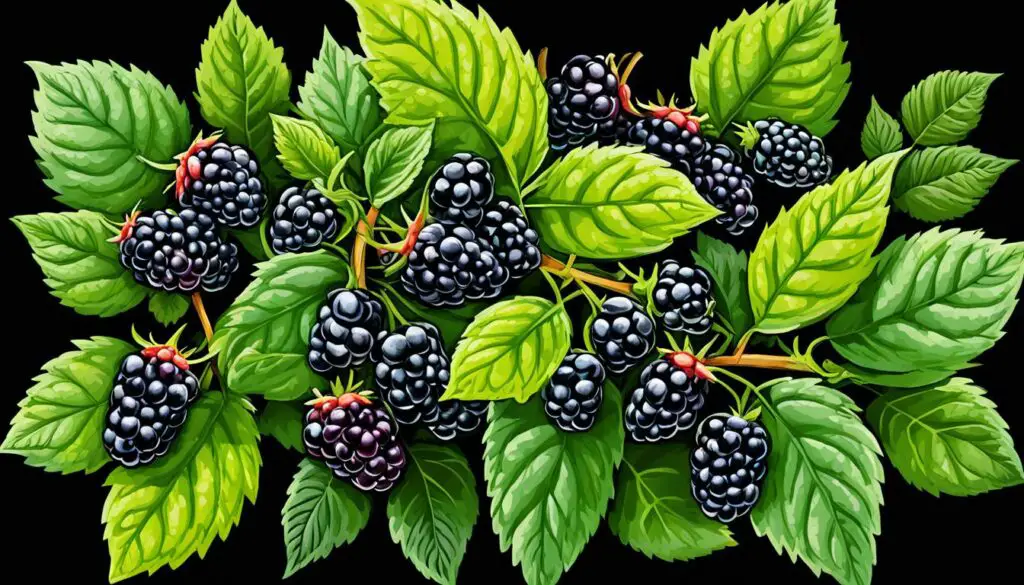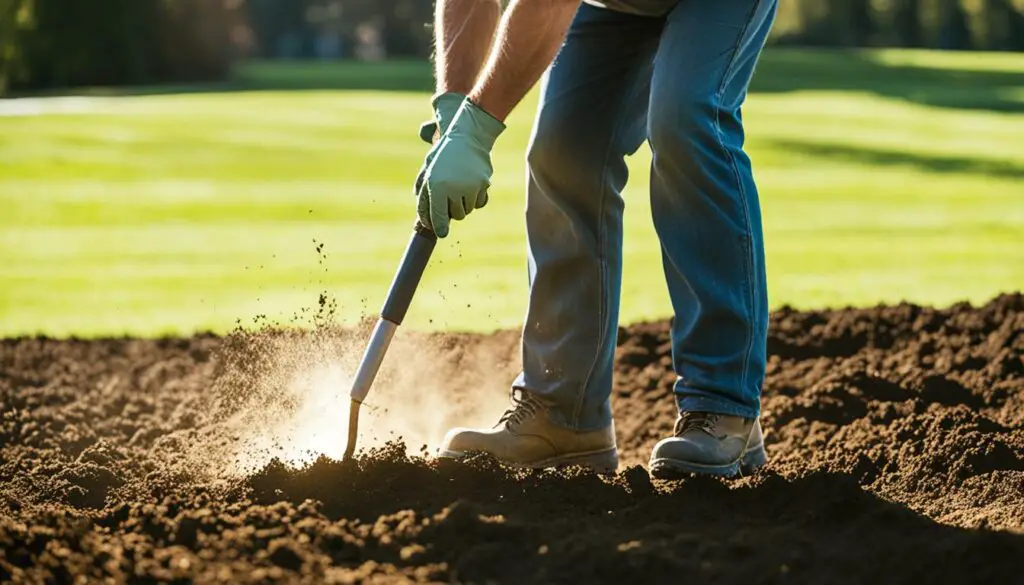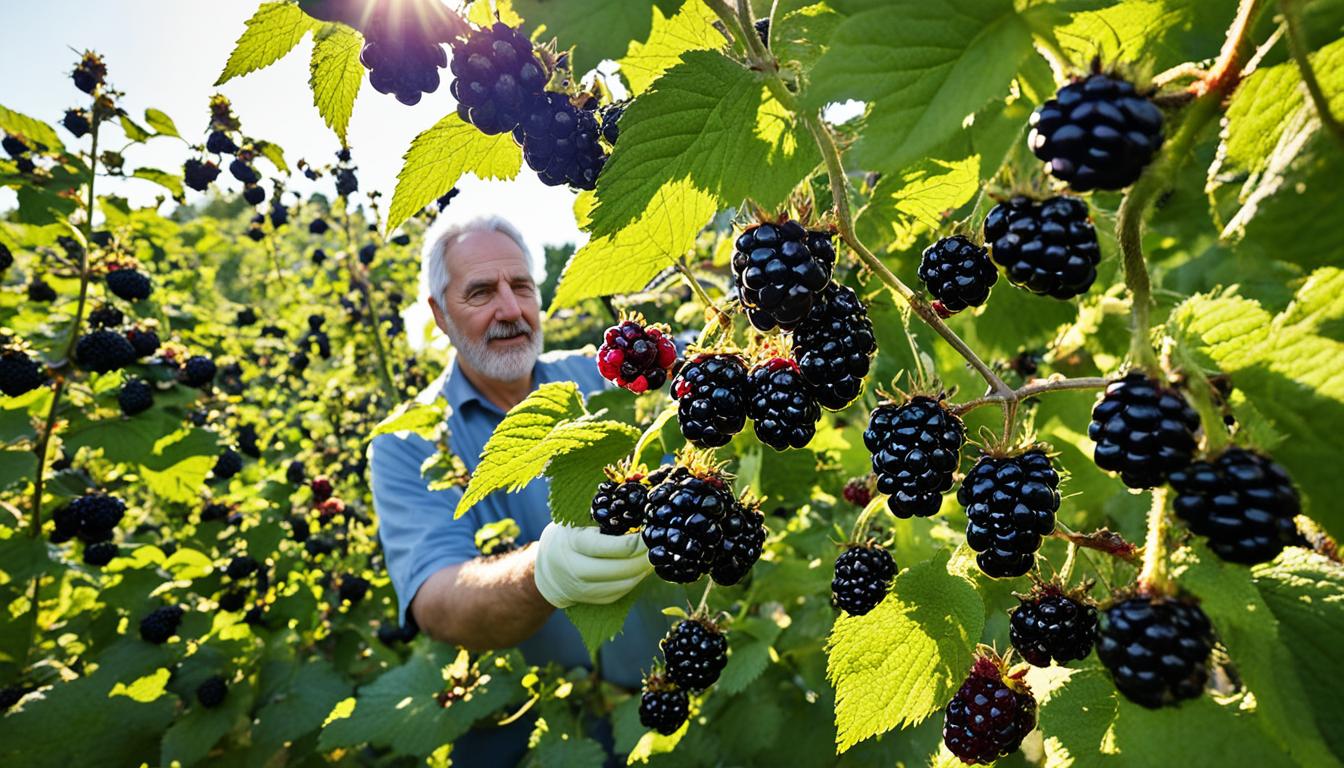Welcome to our comprehensive guide on cultivating blackberries. Whether you’re a seasoned gardener or a beginner, this guide will provide you with all the information you need to successfully grow delicious blackberries in your own backyard. From planting to caring for your plants, we’ll walk you through each step of the process to ensure a bountiful harvest of sweet, juicy berries.
Blackberries are a popular fruit that can be enjoyed fresh, in jams and jellies, or in baked goods. Not only are they delicious, but they are also rich in antioxidants and vitamins, making them a healthy addition to your diet. By following our tips and techniques, you’ll be able to grow your own blackberries and enjoy the satisfaction of picking them fresh from your garden.
Key Takeaways:
- Blackberries are a versatile and healthy fruit that can be enjoyed fresh or used in various culinary creations.
- By following our guide, you can successfully grow blackberries in your own backyard.
- Understanding the different blackberry varieties and their specific requirements is important for successful cultivation.
- Proper soil preparation, including amending the soil and ensuring proper drainage, is crucial for optimal blackberry growth.
- In-season care, including watering, mulching, and fertilization, is necessary to keep your blackberry plants healthy and productive.
Understanding Blackberry Varieties and Their Requirements

Before you start growing blackberries, it’s important to understand the different varieties available and their specific requirements. Blackberries come in several species, each with its own set of attributes. We’ll help you decode the plant attributes of blackberries, such as their common name, botanical name, family, plant type, mature size, sun exposure, soil type, soil pH, bloom time, flower color, hardiness zones, and native area.
Decoding Blackberry Plant Attributes
When choosing a blackberry variety to cultivate, it’s crucial to familiarize yourself with its plant attributes. These attributes provide valuable insights into the growth habits and characteristics of the blackberry plant. Below are the key plant attributes you should consider:
- Common name: The commonly used name for a particular blackberry variety.
- Botanical name: The scientific name assigned to the blackberry variety.
- Family: The botanical family to which the blackberry variety belongs.
- Plant type: Whether the blackberry plant is an upright plant or a trailing vine.
- Mature size: The estimated height and width of the fully grown blackberry plant.
- Sun exposure: The amount of sunlight required by the blackberry variety for optimal growth.
- Soil type: The preferred soil composition and texture for the blackberry variety.
- Soil pH: The ideal pH level of the soil in which the blackberry plant thrives.
- Bloom time: The period during which the blackberry plant produces flowers.
- Flower color: The color of the flowers produced by the blackberry plant.
- Hardiness zones: The specific regions or climate zones where the blackberry variety can withstand winter temperatures.
- Native area: The geographical region where the blackberry variety is originally found.
Assessing Soil and Climate Suitability for Blackberries
Blackberries have specific soil and climate requirements to thrive and produce abundant fruits. Assessing the suitability of your soil and climate for blackberry cultivation is crucial for successful growth. Consider the following factors:
- Soil suitability: Blackberries prefer well-draining soils with a pH range of 5.5 to 6.5. Sandy loam or loamy soil types are ideal.
- Moisture requirements: Blackberry plants require regular watering, but excess moisture can lead to root rot. Proper irrigation is essential.
- Temperature and climate: Blackberries thrive in temperate climates with moderate temperatures. They require a certain number of chilling hours during winter for optimal fruit production.
- Frost tolerance: Some blackberry varieties are more frost-tolerant than others. Consider the average frost dates in your region before choosing a variety.
Identifying the Best Blackberry Cultivars
With numerous blackberry cultivars available, it can be challenging to determine the best ones for your specific needs. However, certain cultivars have gained popularity due to their exceptional flavor, yield, disease resistance, and adaptability. Consider the following highly recommended blackberry cultivars:
| Blackberry Cultivar | Attributes |
|---|---|
| Chester | Large, sweet berries; thornless canes; late-season harvest |
| Arapaho | Medium-sized berries; thornless canes; early-season harvest |
| Ouachita | Large, flavorful berries; thorny canes; mid-season harvest |
| Natchez | Large, firm berries; thorny canes; early-season harvest |
These cultivars are known for their excellent fruit quality and overall performance. However, it’s essential to consider your specific growing conditions and personal preferences when selecting the best blackberry cultivars for your garden.
Preparing the Soil for Optimal Growth

Properly preparing the soil is crucial for the optimal growth of blackberries. By following these essential steps, you can ensure that your blackberry plants have the ideal conditions to thrive and produce a bountiful harvest.
Amending Soil Before Planting
Before planting blackberries, it’s important to amend the soil to provide the right balance of nutrients and organic matter. Start by removing any weeds or grass from the planting area. You can use a garden fork or tiller to loosen the soil and break up any compacted areas.
Next, add organic matter such as well-rotted compost or aged manure to the soil. This will improve its structure and fertility, providing a nutrient-rich environment for the blackberry plants. Spread a layer of compost or manure over the planting area and mix it into the soil to a depth of about 12 inches.
Additionally, consider adding soil amendments such as bone meal or rock phosphate to provide essential nutrients like phosphorus for root development. Follow the recommended application rates specified on the product packaging to avoid over-fertilization.
Once you have amended the soil, rake it to create a smooth surface, removing any large clumps or debris. This will help ensure that the blackberry roots have easy access to nutrients and water.
Drainage and pH Considerations
Proper drainage is crucial for the health of blackberries. Excessive moisture can lead to waterlogging, which can suffocate the roots and promote the growth of harmful fungi. To ensure adequate drainage, choose a planting location with well-drained soil or consider raised beds or hilled rows.
It’s also essential to consider the pH requirements of blackberries. These plants prefer slightly acidic soil with a pH ranging from 5.5 to 6.5. You can test the soil pH using a soil testing kit or by sending a sample to a local agricultural extension service. If the pH is too high, meaning the soil is alkaline, you can lower it by adding elemental sulfur or acidic organic materials such as pine needles or peat moss.
Remember that it’s important to adjust the pH well in advance of planting, as it can take several months for these amendments to take effect. Always follow the recommended application rates to avoid making the soil too acidic.
By considering soil amendments, drainage, and pH requirements, you’ll create the ideal growing environment for your blackberries. This will promote healthy growth, abundant fruit production, and ultimately, a successful and rewarding blackberry cultivation experience.
How to Grow Blackberries: The Planting Process
Once you have prepared the soil, you’re ready to plant your blackberries. Follow our step-by-step guide to ensure the successful establishment of your blackberry plants.
- Selecting Healthy Plants: Choose healthy blackberry plants from a reputable nursery or garden center. Look for plants with strong, disease-free canes and well-developed root systems.
- Determining Spacing: Blackberries need enough space to grow and spread. Leave enough room between plants and rows to allow for proper air circulation and easier maintenance. The specific spacing requirements may vary depending on the blackberry variety you’re planting, so refer to the plant tag or consult a gardening resource for guidance.
- Planting Depth: Dig a hole that is wide and deep enough to accommodate the roots of the blackberry plant. Gently spread out the roots in the hole, making sure they are not bent or crowded. The crown of the plant (the point where the roots meet the canes) should be level with or slightly above the soil surface.
- Caring for Bare-Root Plants: If you’re planting bare-root blackberries, soak the roots in water for about an hour before planting to hydrate them. Trim any damaged or broken roots using clean garden shears. Once planted, water the blackberry plant thoroughly to settle the soil around the roots.
- Handling Tissue Culture Plugs: Tissue culture plugs are young blackberry plants grown in a sterile laboratory environment. When planting tissue culture plugs, handle them carefully to avoid damaging their delicate roots. Place each plug into the planting hole and firm the soil gently around it. Water the plants well after planting.
- Immediate Aftercare: After planting, provide ample water to help the blackberry plants establish their root systems. Apply a layer of organic mulch around the base of each plant to retain moisture, suppress weed growth, and regulate soil temperature.
Ensure that you follow these steps to properly plant your blackberries in the garden. The planting process is a crucial part of successful blackberry cultivation, laying the foundation for healthy growth and abundant fruit production.
In-Season Care: Watering, Mulching, and Fertilization
Proper care during the growing season is essential to maintain the health and productivity of your blackberry plants. In this section, we will discuss important aspects of in-season care, including irrigation strategies, mulching techniques, and fertilization methods.
Irrigation Strategies for Healthy Blackberries
Watering plays a crucial role in the success of your blackberry plants. It is important to provide them with adequate moisture to support their growth and fruit production. Here are some tips for effective watering:
- Water deeply and infrequently to encourage deep root growth.
- Use a soaker hose or drip irrigation system to deliver water directly to the root zone.
- Avoid overhead watering, as it can promote fungal diseases.
- Monitor soil moisture regularly and adjust watering frequency based on the plant’s needs and weather conditions.
Utilizing Mulch in Blackberry Cultivation
Mulching is an essential practice in blackberry cultivation. It helps conserve soil moisture, regulate soil temperature, control weeds, and prevent soil erosion. Here are some tips for effective mulching:
- Apply a layer of organic mulch, such as straw, wood chips, or bark, around the base of the plants.
- Maintain a mulch layer of 2-4 inches to prevent weed growth and retain moisture.
- Avoid placing mulch directly against the stems to prevent stem rot.
- Regularly replenish the mulch as it decomposes.
When and How to Fertilize Your Blackberry Plants
Proper fertilization is essential to provide the necessary nutrients for the growth and development of your blackberry plants. Here are some tips for fertilizing your blackberries:
- Apply a balanced fertilizer, such as a 10-10-10 NPK formula, in early spring before new growth begins.
- Avoid overfertilization, as it can lead to excessive vegetative growth and reduce fruit production.
- Follow the manufacturer’s instructions for application rates and frequency.
- Consider conducting a soil test to determine any specific nutrient deficiencies and adjust the fertilizer accordingly.
By following these watering, mulching, and fertilization tips, you can ensure the health and productivity of your blackberry plants, leading to a bountiful harvest of delicious berries.
| Benefit | Watering | Mulching | Fertilization |
|---|---|---|---|
| Conserves moisture | |||
| Controls weeds | |||
| Regulates soil temperature | |||
| Prevents soil erosion | |||
| Provides necessary nutrients |
Pest Management and Disease Prevention in Blackberries
Like any other plants, blackberries are susceptible to pests and diseases. It’s important to understand common pests that may affect blackberries and how to effectively manage and control them. Additionally, being aware of common blackberry diseases and implementing prevention measures is crucial for the health and productivity of your blackberry plants.
Blackberry Pest Control:
Two common pests that can cause significant damage to blackberries are the blackberry crown borer and the red-necked cane borer. These borers tunnel into the plant, resulting in weakened stems and reduced fruit production. To control these pests, it is important to inspect your plants regularly and remove any infested canes. Pruning the canes during the dormant season is also recommended to remove any overwintering insects. Consider using biological control methods, such as introducing beneficial insects into your garden, to help manage these pests.
Common Blackberry Diseases:
Blackberries can be prone to various diseases, including orange rust, rosette disease, and fungal infections. Orange rust causes orange-colored pustules on the underside of the leaves, leading to stunted growth and reduced fruit yield. Rosette disease, also known as double blossom, causes abnormal growth of lateral shoots and distorted leaves. Fungal infections, such as anthracnose and botrytis rot, can cause fruit rot and leaf spots. Preventing these diseases involves practicing good sanitation by removing and destroying infected plant parts, providing proper air circulation, and avoiding overhead watering. Fungicides may also be used as a preventive measure.
| Pests | Diseases |
|---|---|
| Blackberry crown borer | Orange rust |
| Red-necked cane borer | Rosette disease |
| Anthracnose | |
| Botrytis rot |
By being proactive in managing pests and preventing diseases, you can ensure the health and vitality of your blackberry plants, leading to a successful harvest of juicy, delicious blackberries.
Harvesting and Storing Blackberries for Maximum Freshness
Once your blackberry plants have matured and produced fruit, it’s time to enjoy the fruits of your labor. Follow these blackberry harvesting tips to ensure you pick them at their peak of ripeness for maximum flavor and sweetness. Properly storing blackberries is also crucial to preserve their freshness and extend their shelf life. Additionally, we’ll explore different methods of preserving and freezing blackberries, allowing you to enjoy their deliciousness even when they’re out of season.
Harvesting Tips:
- Wait until the blackberries are fully ripe before harvesting. They should be deep black in color, plump, and easily detach from the plant with a gentle tug.
- Pick blackberries in the early morning or late afternoon when they are cool and have the highest sugar content.
- Handle blackberries with care to prevent bruising. Place them gently in a shallow container to avoid crushing the delicate berries.
Storing Tips:
- Store fresh blackberries in the refrigerator immediately after harvesting. Place them in a single layer on a paper towel-lined tray or in a shallow container with a lid.
- Avoid washing blackberries until you are ready to use them, as moisture can promote mold growth.
- Blackberries are best consumed within a few days of harvesting. If you won’t be able to use them right away, consider freezing or preserving them.
Preserving and Freezing Methods:
If you have an abundant harvest of blackberries, preserving or freezing them ensures you can enjoy their goodness for months to come.
- Preserving: Make blackberry jams, jellies, or preserves to savor the taste of summer all year round. Follow a trusted recipe and canning instructions to preserve the blackberries properly.
- Freezing: Freezing blackberries is a simple and convenient way to extend their shelf life. Wash the berries gently, pat them dry, and spread them in a single layer on a baking sheet. Place the sheet in the freezer until the berries are frozen solid. Then transfer them to a freezer-safe bag or container for long-term storage.
By following these blackberry harvesting and storage tips, you can enjoy the fresh taste of blackberries throughout the year. Whether you prefer eating them fresh or preserving their flavors, blackberries are a versatile fruit that adds sweetness and nutrition to a variety of dishes.
| Method | Advantages | Disadvantages |
|---|---|---|
| Refrigeration | Maintains freshness for a few days | Limited shelf life |
| Canning | Preserves flavor for an extended period | Requires additional preparation and equipment |
| Freezing | Long-term storage option | Texture may be slightly affected |
Conclusion
In conclusion, cultivating blackberries in your own backyard can be a rewarding experience that allows you to enjoy the freshness and flavor of homegrown berries throughout the growing season. By following the step-by-step guide and tips provided in this comprehensive blackberry cultivation guide, you’ll be well-equipped to successfully nurture and care for your blackberry plants.
Remember to start by understanding the different blackberry varieties and their specific requirements, such as soil type, sun exposure, and hardiness zones. Preparing the soil by amending it with the right balance of nutrients and organic matter is crucial for optimal growth. Additionally, ensuring proper drainage and adjusting the pH levels will help create a favorable environment for your blackberry plants.
Once the soil is prepared, it’s time to plant your blackberries, considering spacing and depth requirements. Throughout the growing season, make sure to provide adequate watering, utilize mulch to conserve moisture and control weeds, and fertilize your plants at the right time for optimal growth and fruit production.
As with any plants, blackberries may face pest and disease challenges. Implementing effective pest management strategies and taking preventive measures against common blackberry diseases will help maintain the health of your plants. Lastly, when it’s time to harvest your blackberries, do so at the peak of ripeness and follow proper storage techniques to maximize their freshness and extend their shelf life.
By following these guidelines, you’ll be able to enjoy the deliciousness of freshly picked blackberries from your own backyard. So grab your gardening tools and get ready to experience the joy of growing your own blackberries! Happy blackberry growing!
